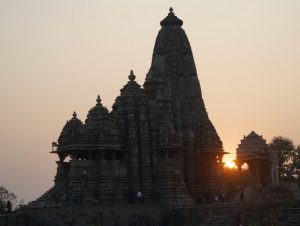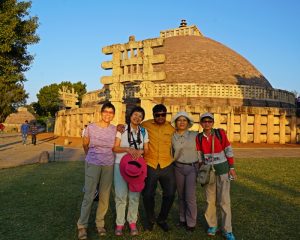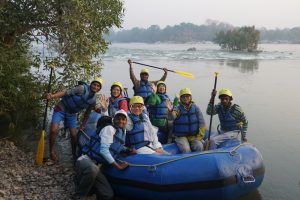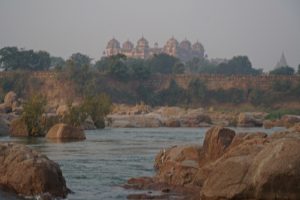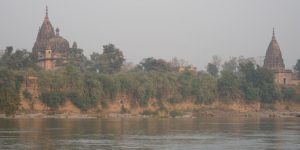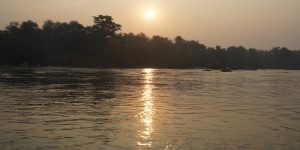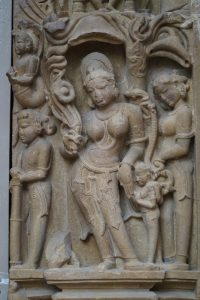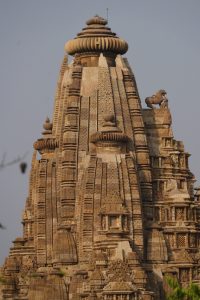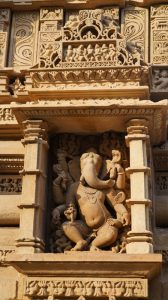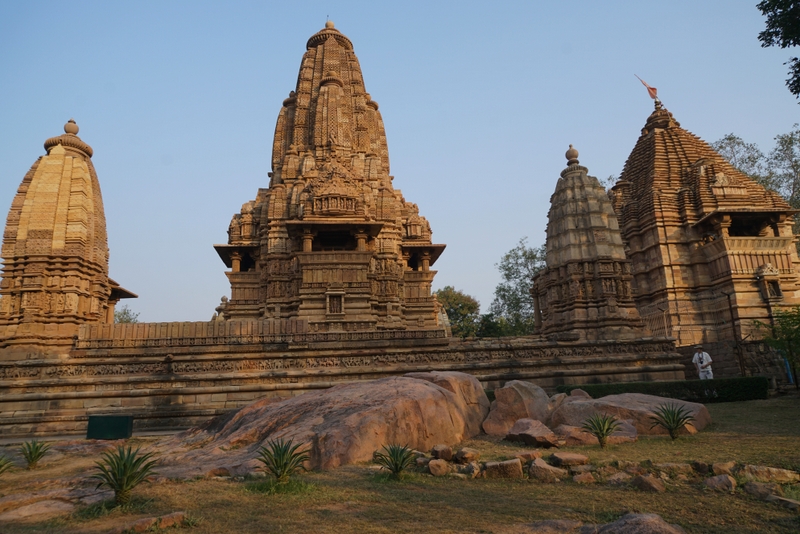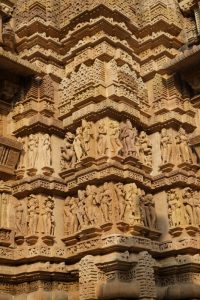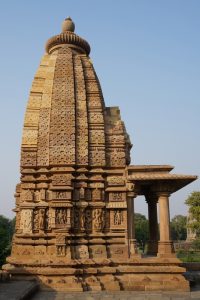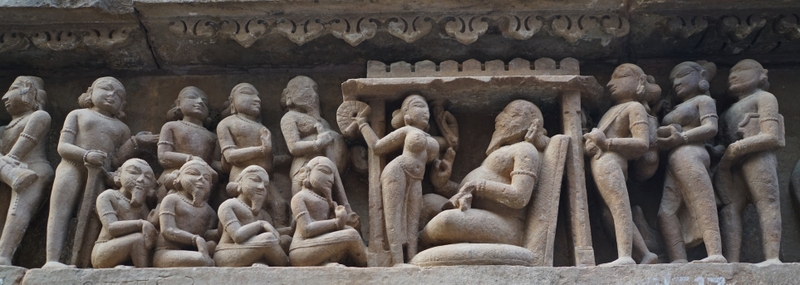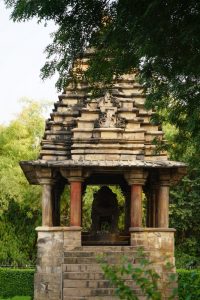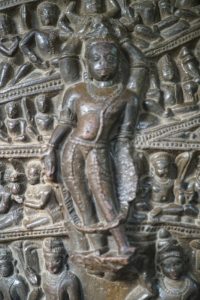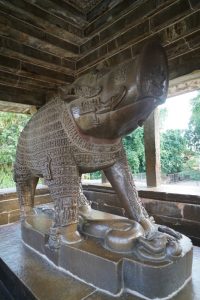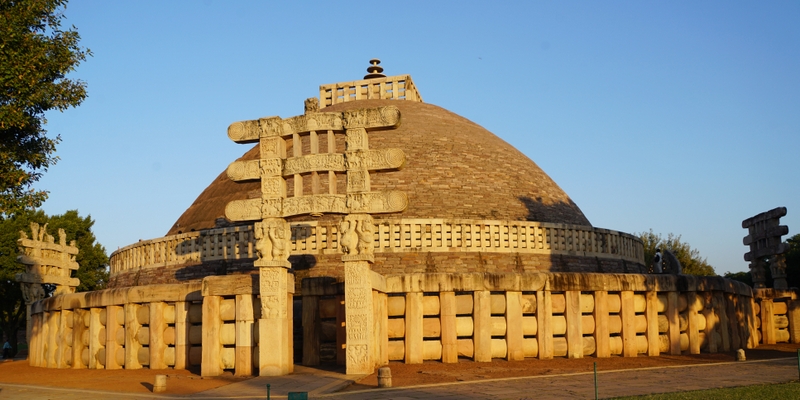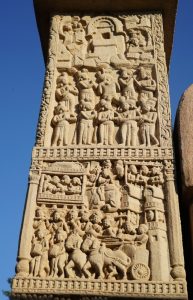November 22 – 24: Khajuraho, Chanderi and Sanchi
Day 5 November 22 Wednesday: Orchha – Khajuraho 173km
At the suggestion of our local guide, we took a boat ride (1500 rupees pp) on Betwa River at 6:30am. Orchha is residence to the Bundella style of structural design. The views of the majestic palaces, temples and ruins on a boat at sunrise is romantic as well as mesmerising.
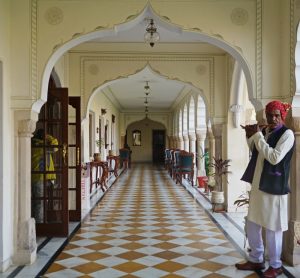 We returned to the hotel for a lovely breakfast and did not leave till 10am. It’s a long drive and we did not arrive after 2pm. After a quick lunch, we met our local guide for a whirlwind tour of the Khajuraho Group of Monuments, comprising a group of Hindu and Jain temples built between AD 900 and 1130 by the Chandella rulers who ruled over Jejakabhukti in central India between 9th and 13th century. The nagara (northern style) of temple architecture reached its zenith during this period. Local tradition lists 85 temples spreading over 20km². The temple town however sank after the demise of the Chandella dynasty till 1838 when T S Burt, a British engineer ventured into the forest and brought Khajuraho back to limelight.
We returned to the hotel for a lovely breakfast and did not leave till 10am. It’s a long drive and we did not arrive after 2pm. After a quick lunch, we met our local guide for a whirlwind tour of the Khajuraho Group of Monuments, comprising a group of Hindu and Jain temples built between AD 900 and 1130 by the Chandella rulers who ruled over Jejakabhukti in central India between 9th and 13th century. The nagara (northern style) of temple architecture reached its zenith during this period. Local tradition lists 85 temples spreading over 20km². The temple town however sank after the demise of the Chandella dynasty till 1838 when T S Burt, a British engineer ventured into the forest and brought Khajuraho back to limelight.
Today, 25 temples divided into the Eastern and Western Group and spreading over 6km², survive in various stages of preservation. The group of temples has been listed on the World Heritage List for their ‘outstanding universal value’ and ‘human creative genius’. The temples are famous for their nagara-style architectural symbolism, intricate details and sculptures, the erotic ones in particular. Layout of the main temples is similar: ardha-mandapa (entrance-porch), mandapa (hall), maha-mandapa with lateral transepts with balconied windows, antarala (vestibule) and sanctum with an ambulatory and three transepts. The architecture is an assemblage of porches and towers that terminates in a shikhara or spire, a feature which was common from the 10th century onwards in the temples in Central India.
Most of the temples are built of a fine-grained sandstone, in varying shades of pink or pale yellow, brought from the quarries of Panna on the east bank of the Ken river. The Khajuraho sculpture can be broadly divided into five categories namely formal cult-images; family, attendant and enclosing divinities; apsaras (heavenly nymph) and sura-sundaris (beautiful nymph); secular themes including teachers and disciples, dancers and musicians, erotic couples or groups etc, and animals.
Nine temples most visited temples are located in the Western Group. As the park would close at 5pm, our local guide only tried to show us to the main ones.
Lakshmi Temple. A small temple dedicated to Goddess Lakshmi, consort of Vishnu
Lakshmana Temple. A magnificant temple built by Yasovarman (c.930-950) and dedicated to Vishnu, it is the only temple that preserves intact all the subsidiary shrines and the platform with its mouldings and friezes. The latter shows a moving pageant of hunting and battle-scenes, processions of elephants, horses and soldiers.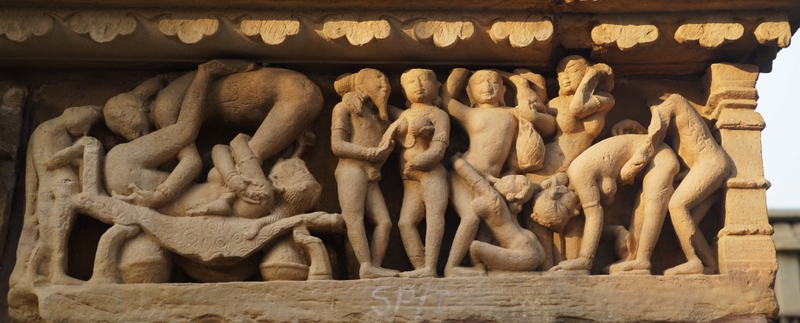
Varaha Temple. It is one of the earlier and less splendid temples (dating c.900 -925). The image of a boar (third incarnation of Vishnu) measuring 2.5 metre long and 1.5 metre high, is covered with figures of Brahmanical gods and goddesses.
Kandariya-Mahadeva Temple. Built by Vidyahara (c.1017-29) over a plan of 31 metres long and 20 metres wide with the main tower reaching a height of 31 metres, this Shiva temple is the most ornate, the largest and grandest temple in Khajuraho. It is considered one of the best examples of temples preserved from the medieval period of India and one of the most sublime creations of Indian architecture.
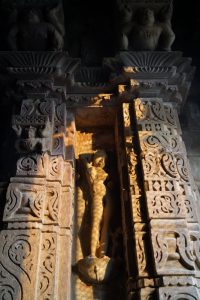
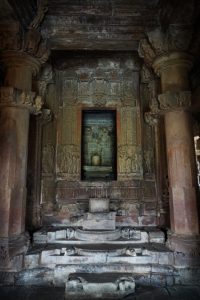
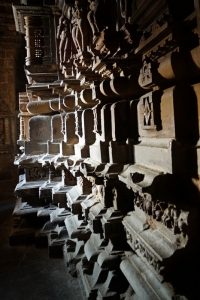 The grand sikhara is decorated with an ascending series of 84 smaller replicas of itself. It is the only temple in Khajuraho where the platform shows projections on the lateral sides and the rear, corresponding to the projections of the transepts. It also has the loftiest basement with the most numerous and elegantly-ornamented mouldings, which include two rows of processional-friezes teeming with elephants and horses, warriors, hunters, dancers, musicians and scenes of erotic couples. Above the friezes there are three bands of beautifully carved and sculptured tall and slender gods and goddesses, apsaras, sura-sundaris etc.
The grand sikhara is decorated with an ascending series of 84 smaller replicas of itself. It is the only temple in Khajuraho where the platform shows projections on the lateral sides and the rear, corresponding to the projections of the transepts. It also has the loftiest basement with the most numerous and elegantly-ornamented mouldings, which include two rows of processional-friezes teeming with elephants and horses, warriors, hunters, dancers, musicians and scenes of erotic couples. Above the friezes there are three bands of beautifully carved and sculptured tall and slender gods and goddesses, apsaras, sura-sundaris etc.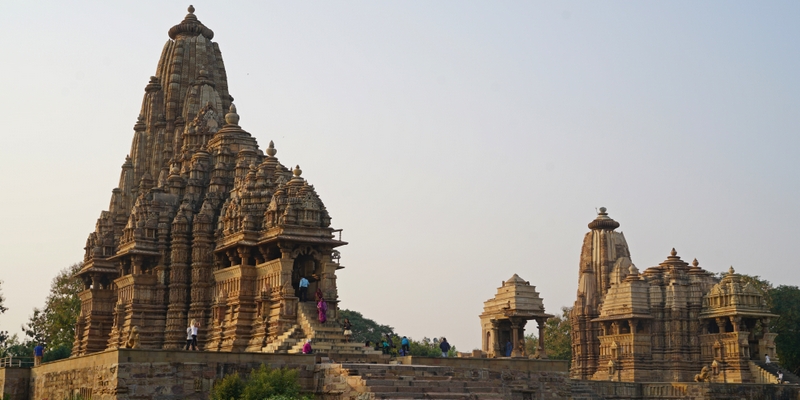
Jagadambi Temple originally dedicated to Vishnu, it is now named for the image of Parvati, consort of Shiva.I was overwhelmed and speechless at the sight of these exquisitely beautiful and breath-taking ancient temples. I have seen pictures before but cannot find words to fully describe the awe and admiration I have for the unbelievably detailed, life-like and fine sculptures. Since it’s impossible to fully appreciate these mind-blogging art works in two hours, I simply enjoyed the sense of being there and was mesmerised by the golden sunset rays lighting up the gods and goddesses in the inside the Kandariya-Mahadeva Temple. I watched sun setting behind the soaring towers of the temple on my way out.
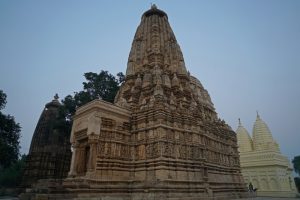 Then we drove a short distance to the Eastern Group. It was getting dark when we arrived at the Parshvanatha Temple (c.950-70). Originally dedicated to Tirthankara, it is one of the finest monuments of Khajuraho and the largest and best preserved amongst the Jaina temples. The design and composition are slightly different from the Hindu temples though it bears a significant resemblance to Lakshmana Temple.
Then we drove a short distance to the Eastern Group. It was getting dark when we arrived at the Parshvanatha Temple (c.950-70). Originally dedicated to Tirthankara, it is one of the finest monuments of Khajuraho and the largest and best preserved amongst the Jaina temples. The design and composition are slightly different from the Hindu temples though it bears a significant resemblance to Lakshmana Temple.
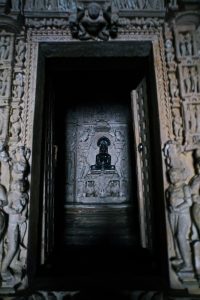 Nearby is the Adinatha Temple girdled by three bands of elegant sculptures including charming sura-sundaris. Though smaller than Parshvanatha, it is noteworthy for the elegance of its sculptures and the roof of the vestibule. I got a glimpse of a black stone statute of Adinatha in sitting posture inside the temple.
Nearby is the Adinatha Temple girdled by three bands of elegant sculptures including charming sura-sundaris. Though smaller than Parshvanatha, it is noteworthy for the elegance of its sculptures and the roof of the vestibule. I got a glimpse of a black stone statute of Adinatha in sitting posture inside the temple.
Before leaving we stopped at the Santinatha Temple, a modern Jaina temple housing a 4.5-metre high image of Adinatha which is said to be dated to 1027-28. Our guide briefly outlined main features of Jainism.
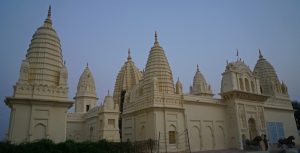 Jainism is an ancient Indian religion. Its followers are called “Jains” a word derived from the Sanskrit word jina (victor) referring to a human being who has conquered all inner passions (like anger, attachment, greed and pride) and possess Kevala Jnana (pure infinite knowledge). It connotes the path of victory in crossing over life’s stream of rebirths through an ethical and spiritual life. Jains trace their history through a succession of 24 victorious saviours and teachers known as Tirthankaras, with the first being Rishabhanatha who is believed to have lived millions of years ago and the 24th being the Mahavira around 500BCE. Jains believe that Jainism is an eternal dharma with the Tirthankaras guiding every cycle of the Jaincosmology. Its main premises are non-violence, many-sidedness, non-attachment and asceticism. Jains take five main vows: non-violence, truth, not stealing, celibacy or chastity and non-attachment. Jainism has between four and five million followers and Jains are predominantly vegetarian. There are some similarities with Hinduim but temples, gods, rituals, fasts and other religious objects are different.
Jainism is an ancient Indian religion. Its followers are called “Jains” a word derived from the Sanskrit word jina (victor) referring to a human being who has conquered all inner passions (like anger, attachment, greed and pride) and possess Kevala Jnana (pure infinite knowledge). It connotes the path of victory in crossing over life’s stream of rebirths through an ethical and spiritual life. Jains trace their history through a succession of 24 victorious saviours and teachers known as Tirthankaras, with the first being Rishabhanatha who is believed to have lived millions of years ago and the 24th being the Mahavira around 500BCE. Jains believe that Jainism is an eternal dharma with the Tirthankaras guiding every cycle of the Jaincosmology. Its main premises are non-violence, many-sidedness, non-attachment and asceticism. Jains take five main vows: non-violence, truth, not stealing, celibacy or chastity and non-attachment. Jainism has between four and five million followers and Jains are predominantly vegetarian. There are some similarities with Hinduim but temples, gods, rituals, fasts and other religious objects are different.
It was late when we met up with Mukesh for dinner. We returned to the restaurant where we had lunch and had an enjoyable time. Mukesh looked more relaxed especially after we treated him with a small bottle of whiskey (900rupees!). We checked in the luxurious Lalit Hotel after 9pm. Unfortunately all the rooms had been taken and we were arranged to stay in a 2-bedroom apartment. Later, we discovered the boiler in Bing’s room did not work. Two workers came and when they could not fix it, they took it down and replaced it with another used one. It was almost midnight when they finished the job! Had we known their work plan, we would have told them to stop. Bing and Flora could use our bathroom anyway. I went to bed after midnight.
Day 6 November 23 Thursday: Khajuraho – Chanderi 230km
Mukesh told us it might be possible to see tigers in the Panne Tiger Reserve/Panne National Park which is about 30km from Khajuraho. So we joined a safari (US$40pp) and left the hotel at 4:30am!
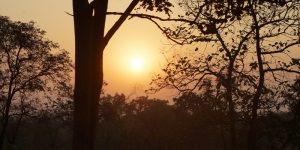 Over 20 jeeps with tourists wrapped up in blanket or warmly cladded were lining up outside the park gate by the time we arrived around 5:15am. We entered the reserve before 5:30am and drove for three hours. As Mukesh had not warned us about the freezing temperature, we all came unprepared. I only had two wind-breakers but no fleece or down jacket. The temperature hoovered below 10ºC and we were almost frozen to death. Flora rubbered her hands all the time to keep her warm.
Over 20 jeeps with tourists wrapped up in blanket or warmly cladded were lining up outside the park gate by the time we arrived around 5:15am. We entered the reserve before 5:30am and drove for three hours. As Mukesh had not warned us about the freezing temperature, we all came unprepared. I only had two wind-breakers but no fleece or down jacket. The temperature hoovered below 10ºC and we were almost frozen to death. Flora rubbered her hands all the time to keep her warm.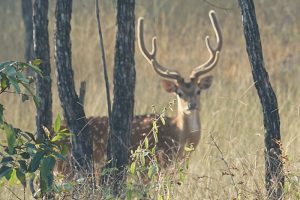
The park has an area of 542km². But only about 20% of the land is open to visitors and jeeps can only drive along designated paths. It is said that tiger, leopard, chinkara, nilgai, sambhar, sloth and over 200 species of birds can be found in the park. The tiger population is estimated to be 35. In any case, tigers are elusive and the chance of sighting a tiger is very slim!
I was cold and not in a mood to enjoy the landscape. We saw a dozen of animals including sambhar deers, a wild boar and many peacocks. As the sun came out, our mood improved as we no longer shivered. Of course, we did not find any tiger!
By the time we arrived at the hotel, it was close to 10am. The buffet breakfast was excellent and we decided not to rush. We set off an hour later. It is a long but pleasant drive to Chanderi: we were driving on country roads passing through villages and small towns. The soil looks rich and the fields are under cultivation. There is no sign of deprivation or visible poverty as evidenced in Bihar. 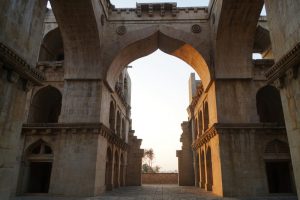
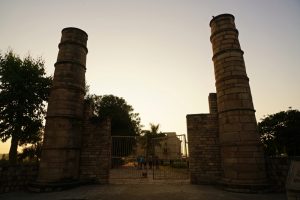 Before going to Amraee Guest House run by a NGO we drove through the city of Chanderi to reach the Afgani-styled Koshal Mahal around 5pm. The palace ruin was built in the 15th century by the Sultan of Malwa to commemorate his Jaunpur victory. Its plan look like a Greek Cross with the four quadrants having similar symmetrical measurements and architecture. The building with three complete storeys and part of the fourth story is a fine example of medieval architecture. I watched sunset from the roof top with panoramic views of the expansive plain without inhabitation and distant range of mountains.
Before going to Amraee Guest House run by a NGO we drove through the city of Chanderi to reach the Afgani-styled Koshal Mahal around 5pm. The palace ruin was built in the 15th century by the Sultan of Malwa to commemorate his Jaunpur victory. Its plan look like a Greek Cross with the four quadrants having similar symmetrical measurements and architecture. The building with three complete storeys and part of the fourth story is a fine example of medieval architecture. I watched sunset from the roof top with panoramic views of the expansive plain without inhabitation and distant range of mountains.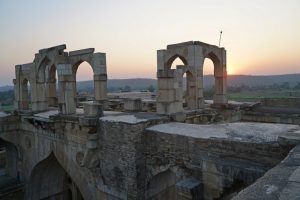
The Amraee Guest House though rustic, is reasonably clean and tidy. Above all the toilet is clean and there is hot water for shower. Siu Mui and I stayed in a brick hut without window. But the walls are brightly decorated with cheerful paintings. Two local men prepared dinner for us while Flora cooked a vegetable dish. Bing also opened a can of abalone from Hong Kong. We had a wholesome and surprisingly delicious dinner! We went to bed early and I had a sweet sleep.
Day 7 November 24 Friday: Chanderi – Vidisha 156km – Sanchi 16km – Bhopal 60km
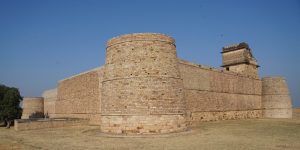 Chanderi located strategically on the borders of Malwa and Bundelkhand and surrounded by hills southwest of the Betwa River, has been an important miltary outpost and properous trading centre. At the time of the Mughal Emperor Akbar, Chanderi had 1400 stone houses and boasted 384 markets, 360 spacious caravan sarais (resting places) and 12,000 mosques. Today, it remains is a town of historical importance with several monuments of the Bundela Raiputs and Malwa sultans. The area has also been a major centre of Jain culture and famous for its exquisite hand-woven saris.
Chanderi located strategically on the borders of Malwa and Bundelkhand and surrounded by hills southwest of the Betwa River, has been an important miltary outpost and properous trading centre. At the time of the Mughal Emperor Akbar, Chanderi had 1400 stone houses and boasted 384 markets, 360 spacious caravan sarais (resting places) and 12,000 mosques. Today, it remains is a town of historical importance with several monuments of the Bundela Raiputs and Malwa sultans. The area has also been a major centre of Jain culture and famous for its exquisite hand-woven saris.
We had another packed day. Leaving our guest house at 8:45am, we arrived at the expansive Mughal Chanderi Fort which dominates the skyline of the old town. The fortification walls were constructed mainly by the Muslim rulers of Chanderi. Situated on a hill 71 metre above the town, it affords the best panoramic views of the whole area. From here, I can appreciate its strategic importance in the old days: the whole area is protected by a 40-km long natural rampart fromed by mountain ranges and connected by walls, fortresses and outposts. The small mosque in the fort has fine carved pillars.
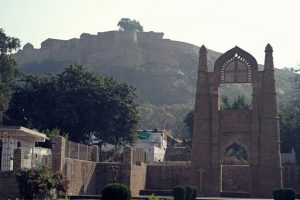 We stopped at the beautiful monumental 15-m high Badal Mahal Gate. I wandered off the main path and found two impressive water tanks. We could not visit the Chanderi Museum as it was closed on Friday. By 10am, we were out of Chanderi.
We stopped at the beautiful monumental 15-m high Badal Mahal Gate. I wandered off the main path and found two impressive water tanks. We could not visit the Chanderi Museum as it was closed on Friday. By 10am, we were out of Chanderi.
Raja took the country roads which are more pleasant, tranquil and green. At this time of the year, most of the fields are under cultivation (mostly wheat). According to Mukesh, the wheat woud be ready for harvast around February. Between March and May, the farmers would rest and often go on pilgrimage trips. During the monsoon season in the summer, they would grow rice and other crops like lentils.
We stopped at an eatery by the roadside and had local food. Mukesh, Raja and Raju had thali (a set meal) for 50 rupees. We ordered a vegetarian fried rice, four pieces of chapatis and mashala tea. The lunch for seven cost only 300 rupees!
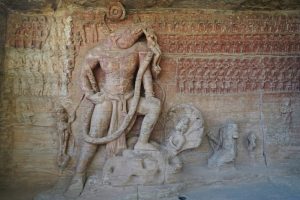
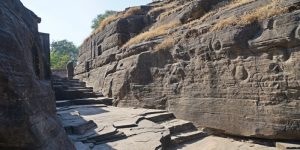 Mukesh knows the area well and suggested to see the Udaygiri Caves near Vidisha on our way toSanchi. We appreciate his initiative as this spot was not on the itinerary. The 20 rock-cut caves created from the early years of the 5th century and verifiably associated with a Gupta period, contain some of the oldest surviving Hindu temples annd iconography of Vaishnavism (Vishnu), Shaktism (Durga and Matrikas) and Shavism (Shiva) in India.
Mukesh knows the area well and suggested to see the Udaygiri Caves near Vidisha on our way toSanchi. We appreciate his initiative as this spot was not on the itinerary. The 20 rock-cut caves created from the early years of the 5th century and verifiably associated with a Gupta period, contain some of the oldest surviving Hindu temples annd iconography of Vaishnavism (Vishnu), Shaktism (Durga and Matrikas) and Shavism (Shiva) in India.
A local guide showed us half a dozen caves within an hour. We started at the iconic Cave 5 a shallow niche which contains the much-celebrated colossal Varaha (third avatar of Vishnu) panel. It is the narrative of Vishnu rescuing goddess earth in crisis.
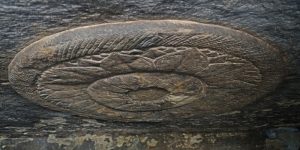
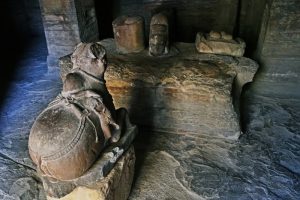 We took a quick look at Cave 6 and 7 nearby before walking uphill through a narrow passage to Cave 8 (the Tawa (a saucepan) Cave) which though badly damaged, has a remarkably beautiful lotus carving on its ceiling.
We took a quick look at Cave 6 and 7 nearby before walking uphill through a narrow passage to Cave 8 (the Tawa (a saucepan) Cave) which though badly damaged, has a remarkably beautiful lotus carving on its ceiling.
We cast a quick look at the Veena Cave and Kumara Cave before arriving at Cave 13 contains a 3.66 metre-long image of Sheshashayi Vishnu lying on the coils of the primeval snake. The kneeling figure below is generally interpreted as Chandragupta II symbolising his devotion to Vishnu and the other fighure is likely his minister Virasena.
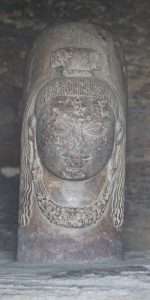 Then we drove a short distance to reach Cave 4 (Vina Cave) which represents both Shaiva and Shakti themes. River goddesses Ganga and Yamuna flank the doorway on two short pilasters with bell capitals. The temple sanctum is dedicated to Shiva containing an impressive siva-linga with a face carved on it.
Then we drove a short distance to reach Cave 4 (Vina Cave) which represents both Shaiva and Shakti themes. River goddesses Ganga and Yamuna flank the doorway on two short pilasters with bell capitals. The temple sanctum is dedicated to Shiva containing an impressive siva-linga with a face carved on it.
Buddhist Monuments of Sanchi
The Buddhist monuments on a hilltop at Sanchi town are located 46km north-east of Bhopal. Sanchi is in fact the centre of a region with a number of stupas including Satdhara, Morel Khurd, Andher, Mawas, Sonari etc. all lying within 20km of Sanchi.
The monuments (including monolithic pillars, palaces, temples and monasteries), record the genesis, efflorescene and decay of buddhist art and architecture over a period of thirteen hundred years (from the third century BC to twelfth century AD). It is the oldest Buddhist sanctuary in existence and was a major Buddhist centre in India. But from 14th century onward Sanchi was left deserted and unnoticed. It came into public notice in 1818 when General Taylor discovered the ruins and found Stupas 1, 2 and 3 intact. Repair and preservation work began in 1881.
Today, all monuments except Stupa 2 and Monastery 51 are located in three well-defined areas (Main Terrace, the Eastern Area and the Southern Area) in a plateau on the top of the hill measuring about 384 metres from north to south and 201 metres from east to west.
We stayed in this World Heritage Site for two and a half hours. There were few tourists and the place was tranquil. There is too much to see. I only had time to look at Stupas 1, 2 and 3, and a couple of temples and monasteries. Ashoka had chosen this site in the third century BCE to construct a stupa to enshrine the Buddha’s relic as his wife Devi was born in Sanchi and they got married here. 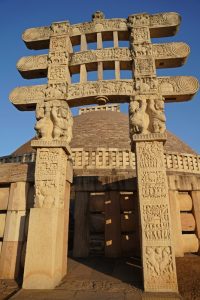
Stupa 1, the Great Stupa, is one of the oldest stone structures in India. Its nucleus was a simple hemispherical brick structure (36.6 metres in diameter and a height of 16.46 metres excluding the railing and umbrella) built over the relics of the Buddha. It was crowned by the chatra (a parasol-like structure) symbolising high rank which was intended to honour and shelter the relics.
In the first century BCE four elaborately carved toranas (ornamental gateways ) and a balustrade (a railing supported by balusters) encircling the entire structure were added. During the Gupta period (around AD 450), four images of the Buddha each seated under a pillared canopy, were installed against the walls of the stupa, facing the four entrances. An Ashoka Pillar which was once erected next to the South Gateway, has fallen.
The most impressive feature is the elaborate and beautiful carvings on the gateways which may be broadly classified into five subject-matters. They include scenes from the Jatakas and the Buddha’s life, scenes relating to the Manushi-Buddhas, events in the subsequent history of Buddhism, and miscellaneous scenes and decorations. 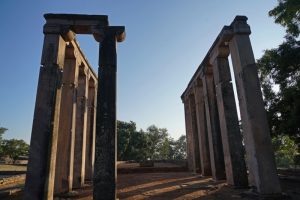
Close to the South Gateway, we saw the majestic ruin of Temple 18 which looks like a Greek temple. The nearby Temple 17 standing on a low moulded basement, is small but remarkable for its structural propriety, symmetry, logical proportions and restraint in ornamentation.
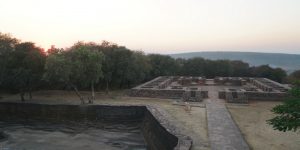 We walked down the western slope to reach a compact and well-preserved monastery (33.22 metres x32.69 metres) with an open courtyard at the centre and 22 cells in total. Our guide said that scholars from different countries had come here to study.
We walked down the western slope to reach a compact and well-preserved monastery (33.22 metres x32.69 metres) with an open courtyard at the centre and 22 cells in total. Our guide said that scholars from different countries had come here to study.
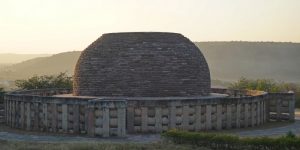 We finally reached Stupa 2 (320 metres downhill from the plateau) which was probably built around the last quarter of the second century BC. The decorations of this stupa have been called “the oldest extensive stupa decoration in existence”. For the first time, clearly Buddhist themes are represented particularly the four events in the life of the Buddha (the nativity, the enlightenment, the first sermon and the parinirvana). The posts of the balustrade are ornamented with one complete and two half medallions. The theme of the reliefs consists mostly of decorative motifs including flora and plant designs, animals – real, mythological and fanciful, birds, fish, nagas, human figures and demi-gods.
We finally reached Stupa 2 (320 metres downhill from the plateau) which was probably built around the last quarter of the second century BC. The decorations of this stupa have been called “the oldest extensive stupa decoration in existence”. For the first time, clearly Buddhist themes are represented particularly the four events in the life of the Buddha (the nativity, the enlightenment, the first sermon and the parinirvana). The posts of the balustrade are ornamented with one complete and two half medallions. The theme of the reliefs consists mostly of decorative motifs including flora and plant designs, animals – real, mythological and fanciful, birds, fish, nagas, human figures and demi-gods.
It was atmospheric to watch the setting sun lighting up the stupa. It was 5:30pm when we looked at Stupa 3 where the relics of Sariputra and Maudgalyayana, the two foremost disciples of the Buddha, had been enshrined. But the relics had been taken to London. This stupa measuring 15 metres in diameter and 8.23 metres in height, was modelled after Stupa 1. But it has only one gateway which was probably built under the Satavahanas around 50 BCE.
Owing to traffic jam, we did not arrive at Noor-US-Sabah Hotel till 8pm. The room is spacious and luxurious with fantastic lake view. We had buffet dinner at the hotel (1100 rupees pp). I washed all my dirty clothes as we would stay in the hotel for two nights. A full and wonderful day!


